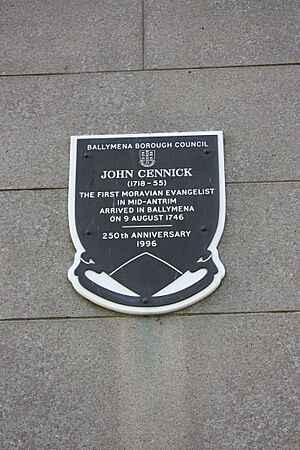Gracehill facts for kids
Quick facts for kids Gracehill * |
|
|---|---|
| Criteria | Cultural: (iii), (iv) |
| Reference | 1468 |
| Inscription history | |
| Inscription | 2015 (39th Session) |
| Extensions | 2024 |
|
|
Gracehill is a special village in County Antrim, Northern Ireland. It's about 1.9 miles from Ballymena. The village is in an area called Ballykennedy, which comes from the Irish words Baile Uí Chinnéide. It is part of the Borough of Mid & East Antrim.
Gracehill is unique in Ireland. It was carefully planned and built by members of the Moravian Church. The name Gracehill shows the religious hopes of the people who started it. There are other places with similar names, like Gracehill in the United States.
In 2024, Gracehill was given UNESCO World Heritage site status. This means it's a very important place globally.
Contents
History of Gracehill Village
The land where Gracehill now stands was once owned by Lord O'Neill. Gracehill was started in 1746 by a religious leader named Reverend John Cennick. He wanted to create a special settlement for the Moravian Church.
Lord O'Neill agreed to let Reverend John Cennick use about 200 acres of land. This land was then divided among the Moravian settlers. These settlers were German-speaking Protestants, also known as the Brethren. Building Gracehill officially began on April 26, 1763.
At first, Reverend John Cennick faced problems. The people who lived on the land before were not happy about leaving. Lord O'Neill had only given them 12 months to move. They did not get any money for losing their land. However, these problems eventually stopped.
The very first building in Gracehill was the Brethren's shop. The founders believed this shop was important for the village's success. They borrowed money to build it, and the shop helped the town grow.
By 1837, Gracehill was a very successful village. It was designed in a square shape, with buildings spreading out from the center. The village had 39 families, all members of the Moravian church. Most families lived in small cottages. Each home had enough land to grow potatoes and keep a farm animal.
The village was also decorated with shrubs and bushes. New buildings were made for religious purposes. These included two main houses for unmarried men (brethren) and unmarried women (sisters). The house for unmarried men was also used as a school. It taught young boys and girls, even those not from Gracehill. It also had a boarding school for young gentlemen. Gracehill also had a small factory that made linen. This helped the village support itself.
Protecting Gracehill's Heritage
Gracehill is a Conservation Area. This means it's a special place protected by law. This protection comes from the Planning Act (Northern Ireland) 2011.
Many buildings in Gracehill are "listed buildings." This means they are historically important.
- The Gracehill Church is a Grade A listed building. This is the highest level of protection.
- The old Gracehill school building is a Grade B listed building.
The old school building was built in 1765. It has two floors and 10 sections, built in the Georgian style. In the 1800s, it taught local children. It also offered places for students to live if they came from other areas. This building was used for classes until 1999. Sadly, it became damaged by rot and fire.
A local group called the Building Preservation Trust was formed. Their goal is to fix the old school building. They want to turn it into a historical center for the village.
Gracehill as a World Heritage Site
Gracehill has a very rich history. Because of this, the local council and the Gracehill Old School Trust worked hard. They wanted Gracehill to be recognized as a World Heritage Site. Their efforts were successful! Gracehill is now Northern Ireland's second World Heritage Site.
This means Gracehill is as important as The Giant's Causeway. However, Gracehill is a cultural site, while the Giant's Causeway is a natural site.
Gracehill was nominated as part of a bigger plan. The United States led this effort to get World Heritage status for Moravian Church settlements. These settlements were founded in the 1700s. Other places included in this nomination were Bethlehem, Pennsylvania in the US and Herrnhut in Germany. These joined Christiansfeld in Denmark, which was already a World Heritage site.
Education in Gracehill
- Gracehill Primary School is the local school for children in the village.
Sports and Recreation
- Galgorm Castle Golf Club is a large golf course near Gracehill. It has 18 holes and covers 220 acres.
Famous People from Gracehill
- Jane Lewers Gray (1796-1871) was an American poet and hymn writer.
- Albert E. S. Smythe (1861–1947) was a Canadian journalist.


